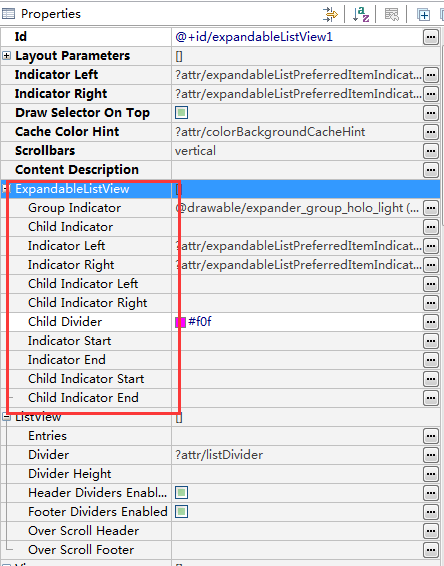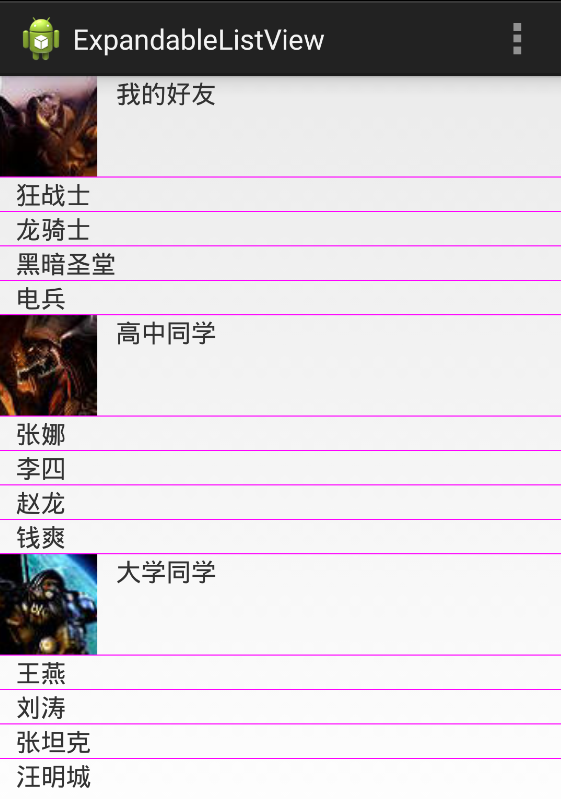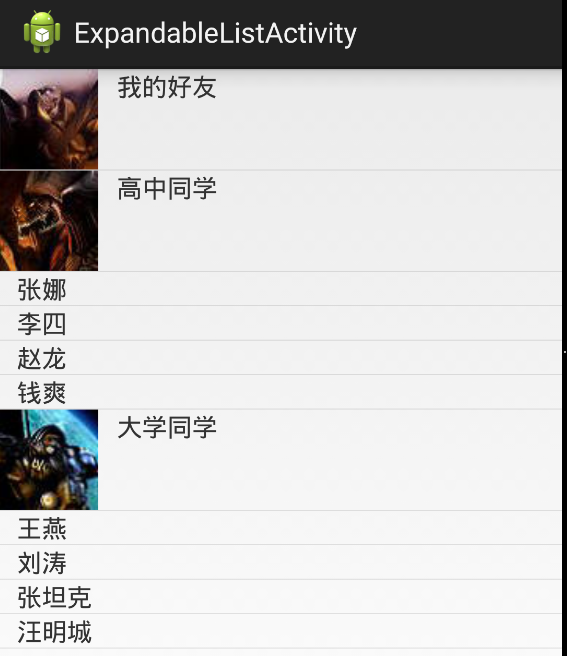ExpandableListViewжШѓListViewзЪДе≠Рз±їпЉМдїЦеЬ®ListViewдЄКињЫи°МдЇЖжЙ©е±ХпЉМеЃГжККеИЧи°®й°єеИЖжИРдЇЖеЗ†зїДпЉМжѓПзїДйЗМеМЕеРЂдЇЖе§ЪдЄ™еИЧи°®й°є
ExpandableListViewзЪДеИЧи°®й°єжШѓзФ±ExpandableListAdapterжПРдЊЫзЪДпЉМеЃЮзО∞ExpandableListAdapterдЄЙзІНеЄЄзФ®жЦєеЉП,еЄЄзФ®зЪДExpandableListAdapterе≠Рз±їе¶ВдЄЛпЉЪ
1пЉМжЙ©е±ХBaseExpandableListAdapterеЃЮзО∞ExpandableListAdapter
2пЉМдљњзФ®SimpleExpandableListAdapterе∞Ж дЄ§дЄ™ListйЫЖеРИеМЕи£ЕжИРExpandableListAdapter
3пЉМдљњзФ®SimpleCursorTreeAdapterе∞ЖCursorдЄ≠зЪДжХ∞жНЃеМЕи£ЕжИРSimpleCursorTreeAdapter
ExpandableListAdapterеПКеЕґе≠Рз±їзЪДзїІжЙњеЕ≥з≥їз±їеЫЊзЬЛињЩзѓЗжЦЗзЂ†иЃ≤зЪДжѓФиЊГе•љпЉМзЬЛжЗВдЇЖпЉЪhttp://hubingforever.blog.163.com/blog/static/1710405792010538823477/
ExpandableListViewзЪДxmlе±ЮжАІпЉЪ

android:childDivider жМЗеЃЪдЄ™зїДеЖЕеРДе≠РеИЧи°®й°єдєЛйЧізЪДеИЖйЪФжЭ°
android:childIndicator жШЊз§Їе≠РеИЧи°®й°єжЧБиЊєзЪДDrawbleеѓєи±°
androidпЉЪgroupIndicator жШЊз§ЇзїДеИЧи°®й°єжЧБиЊєзЪДDrawbleеѓєи±°
ExpandableListViewжШѓandroidдЄ≠еПѓдї•еЃЮзО∞дЄЛжЛЙlistзЪДдЄАдЄ™жОІдїґпЉМжШѓдЄАдЄ™еЮВзЫіжїЪеК®зЪДењГдЇЛдЄ§дЄ™зЇІеИЂеИЧи°®й°єжЙЛй£ОзРіиѓХеЫЊпЉМеИЧи°®й°єжШѓжЭ•иЗ™ExpandableListViewaAdapterпЉМзїДеПѓдї•еНХзЛђе±ХеЉАгАВ
йЗНи¶БжЦєж≥ХпЉЪ
<span style="font-size:24px;">expandGroup (int groupPos) ;//еЬ®еИЖзїДеИЧи°®иІЖеЫЊдЄ≠ е±ХеЉАдЄАзїДпЉМ
setSelectedGroup (int groupPosition) ;//иЃЊзљЃйАЙжЛ©жМЗеЃЪзЪДзїДгАВ
setSelectedChild (int groupPosition, int childPosition, boolean shouldExpandGroup);//иЃЊзљЃйАЙжЛ©жМЗеЃЪзЪДе≠Рй°єгАВ
getPackedPositionGroup (long packedPosition);//ињФеЫЮжЙАйАЙжЛ©зЪДзїД
getPackedPositionForChild (int groupPosition, int childPosition) ;//ињФеЫЮжЙАйАЙжЛ©зЪДе≠Рй°є
getPackedPositionType (long packedPosition);//ињФеЫЮжЙАйАЙжЛ©й°єзЪДз±їеЮЛпЉИChild,GroupпЉЙ
isGroupExpanded (int groupPosition);//еИ§жЦ≠ж≠§зїДжШѓеР¶е±ХеЉА</span>
<span style="font-size:24px;">expandableListView.setDivider();ињЩдЄ™жШѓиЃЊеЃЪжѓПдЄ™GroupдєЛйЧізЪДеИЖеЙ≤зЇњгАВ
expandableListView.setGroupIndicator();ињЩдЄ™жШѓиЃЊеЃЪжѓПдЄ™GroupдєЛеЙНзЪДйВ£дЄ™еЫЊж†ЗгАВ
expandableListView.collapseGroup(int group); е∞ЖзђђgroupзїДжФґиµЈ</span>
дЄАпЉМдљњзФ®жЙ©е±ХBaseExpandableListAdapterжЭ•жПРдЊЫжХ∞жНЃжЇР
жЙ©е±ХBaseExpandableListAdapterйЬАи¶БйЗНеЖЩ11дЄ™жЦєж≥ХпЉЪ
getGroupCount()пЉМињФеЫЮеМЕеРЂзїДеИЧи°®зЪДжХ∞йЗП
getChildrenCount(int groupPosition)пЉМињФеЫЮеМЕеРЂзїДеИЧи°®зЪДжХ∞йЗП
getGroup(int groupPosition)пЉМињФеЫЮзїДеИЧи°®зЪДеѓєи±°
getChild(int groupPosition, int childPosition)пЉМињФеЫЮзїДеИЧи°®дЄЛзЪДе≠РеИЧи°®еѓєи±°
getGroupId(int groupPosition)пЉМињФеЫЮзїДеИЧи°®Id
getChildId(int groupPosition, int childPosition)пЉМињФеЫЮз•ЦеИЧи°®зЪДе≠РеИЧи°®зЪДId
дЄЛйЭҐдЄ§дЄ™е±ЮжАІеЊИйЗНи¶БпЉБ
getGroupView(int groupPosition, boolean isExpanded,
View convertView, ViewGroup parent)пЉМиѓ•жЦєж≥ХеЖ≥еЃЪжѓПдЄ™зїДйАЙй°єзЪДе§ЦиІВгАБ getChildView(int groupPosition, int childPosition,
boolean isLastChild, View convertView, ViewGroup parent)пЉМиѓ•жЦєж≥ХеЖ≥еЃЪжѓПдЄ™е≠РйАЙй°єзЪДе§ЦиІВгАБ**
isChildSelectable(int groupPosition,
int childPosition)пЉЪе¶ВжЮЬchildжЈїеК†зЫСеРђдЇЛдїґпЉМеИЩи¶БињФеЫЮtrue
Main.xml
<?xml version="1.0" encoding="utf-8"?>
<LinearLayout xmlns:android="http://schemas.android.com/apk/res/android"
android:id="@+id/root"
android:layout_width="match_parent"
android:layout_height="match_parent"
android:orientation="vertical">
<!--ExpandableListViewзїДдїґ
android:childDivider жМЗеЃЪдЄ™зїДеЖЕеРДе≠РеИЧи°®й°єдєЛйЧізЪДеИЖйЪФжЭ°
android:childIndicator жШЊз§Їе≠РеИЧи°®й°єжЧБиЊєзЪДDrawbleеѓєи±°
androidпЉЪgroupIndicator жШЊз§ЇзїДеИЧи°®й°єжЧБиЊєзЪДDrawbleеѓєи±°
-->
<ExpandableListView
android:id="@+id/expandableListView1"
android:layout_width="match_parent"
android:layout_height="wrap_content"
android:childDivider="#f0f"
>
</ExpandableListView>
</LinearLayout>
MainActivity.java
package com.hust.expandablelistview;
import android.app.Activity;
import android.os.Bundle;
import android.view.Gravity;
import android.view.Menu;
import android.view.MenuItem;
import android.view.View;
import android.view.ViewGroup;
import android.widget.AbsListView;
import android.widget.AbsListView.LayoutParams;
import android.widget.BaseExpandableListAdapter;
import android.widget.ExpandableListView;
import android.widget.ImageView;
import android.widget.LinearLayout;
import android.widget.TextView;
public class MainActivity extends Activity {
@Override
protected void onCreate(Bundle savedInstanceState) {
super.onCreate(savedInstanceState);
setContentView(R.layout.activity_main);
BaseExpandableListAdapter bela=new BaseExpandableListAdapter(){
/*иЗ™еК®еЃЮзО∞ињЩ10дЄ™жЦєж≥Х
* getGroupCount()пЉМињФеЫЮеМЕеРЂзїДеИЧи°®зЪДжХ∞йЗП
* getChildrenCount(int groupPosition)пЉМињФеЫЮеМЕеРЂзїДеИЧи°®зЪДжХ∞йЗП
*
* getGroup(int groupPosition)пЉМињФеЫЮзїДеИЧи°®зЪДеѓєи±°
* getChild(int groupPosition, int childPosition)пЉМињФеЫЮзїДеИЧи°®дЄЛзЪДе≠РеИЧи°®еѓєи±°
*
* getGroupId(int groupPosition)пЉМињФеЫЮзїДеИЧи°®Id
* getChildId(int groupPosition, int childPosition)пЉМињФеЫЮз•ЦеИЧи°®зЪДе≠РеИЧи°®зЪДId
*
* getGroupView(int groupPosition, boolean isExpanded,
View convertView, ViewGroup parent)пЉМиѓ•жЦєж≥ХеЖ≥еЃЪжѓПдЄ™зїДйАЙй°єзЪДе§ЦиІВгАБ
* getChildView(int groupPosition, int childPosition,
boolean isLastChild, View convertView, ViewGroup parent)пЉМиѓ•жЦєж≥ХеЖ≥еЃЪжѓПдЄ™е≠РйАЙй°єзЪДе§ЦиІВгАБ
*
*
* */
int[] logos=new int[]{
R.drawable.p,R.drawable.z,R.drawable.t
};
//зїДеИЧи°®зЪДжХ∞йЗП
private String[] armTypes=new String[]{"жИСзЪДе•љеПЛ","йЂШдЄ≠еРМе≠¶","е§Іе≠¶еРМе≠¶"};
//зїДеИЧи°®дЄЛзЪДе≠РеИЧи°®й°єпЉМеПѓжЙ©е±ХзЪДExpandableListViewжШѓдЄ™дЇМзїіжХ∞зїД
private String[][] arms=new String[][]{
{"зЛВжИШе£Ђ","йЊЩй™Се£Ђ","йїСжЪЧеЬ£е†В","зФµеЕµ"},
{"еЉ†е®Ь","жЭОеЫЫ","иµµйЊЩ","йТ±зИљ"},
{"зОЛзЗХ","еИШжґЫ","еЉ†еЭ¶еЕЛ","ж±™жШОеЯО"}
};
//ињФеЫЮеМЕеРЂзїДеИЧи°®зЪДжХ∞йЗП
@Override
public int getGroupCount() {
// TODO Auto-generated method stub
return armTypes.length;
}
//ињФеЫЮзїДдљНзљЃдЄЛзЪДе≠РеИЧи°®й°єзЪДжХ∞йЗП
@Override
public int getChildrenCount(int groupPosition) {
// TODO Auto-generated method stub
return arms[groupPosition].length;
}
//ињФеЫЮзїДеИЧи°®зЪДеѓєи±°
@Override
public Object getGroup(int groupPosition) {
// TODO Auto-generated method stub
return armTypes[groupPosition];
}
//ињФеЫЮзїДеИЧи°®дЄЛзЪДе≠РеИЧи°®еѓєи±°
@Override
public Object getChild(int groupPosition, int childPosition) {
// TODO Auto-generated method stub
return arms[groupPosition][childPosition];
}
//ињФеЫЮзїДеИЧи°®Id
@Override
public long getGroupId(int groupPosition) {
// TODO Auto-generated method stub
return groupPosition;
}
//ињФеЫЮз•ЦеИЧи°®зЪДе≠РеИЧи°®зЪДId
@Override
public long getChildId(int groupPosition, int childPosition) {
// TODO Auto-generated method stub
return childPosition;
}
@Override
public boolean hasStableIds() {
// TODO Auto-generated method stub
return true;
}
//иѓ•жЦєж≥ХеЖ≥еЃЪжѓПдЄ™зїДйАЙй°єзЪДе§ЦиІВгАБињЩйЗМињЩеЃЪдєЙзїДеИЧи°®еЄГе±АпЉМдєЯеПѓдї•зФ®xmlжЦЗдїґ
@Override
public View getGroupView(int groupPosition, boolean isExpanded,
View convertView, ViewGroup parent) {
// TODO Auto-generated method stub
LinearLayout ll=new LinearLayout(MainActivity.this);
ll.setOrientation(0);
ImageView logo=new ImageView(MainActivity.this);
logo.setImageResource(logos[groupPosition]);
TextView textview=getTextView();
textview.setText(getGroup(groupPosition).toString());
ll.addView(logo);
ll.addView(textview);
return ll;
}
//иЃЊзљЃTextViewзЪДеПВжХ∞
private TextView getTextView() {
// TODO Auto-generated method stub
AbsListView.LayoutParams lp=new AbsListView.LayoutParams(ViewGroup.LayoutParams.MATCH_PARENT,64);
TextView textview=new TextView(MainActivity.this);
textview.setLayoutParams(lp);//иЃЊзљЃеЄГе±АеПВжХ∞,android:layout_Width="match_parent",android:layout_Height="64"
textview.setGravity(Gravity.CENTER_VERTICAL|Gravity.LEFT);//android:gravity="CENTER_VERTICAL|LEFT"
textview.setPadding(36, 0, 0, 0);
textview.setTextSize(16); //android:textsize="20dp"
return textview;
}
//иѓ•жЦєж≥ХеЖ≥еЃЪжѓПдЄ™е≠РйАЙй°єзЪДе§ЦиІВ
@Override
public View getChildView(int groupPosition, int childPosition,
boolean isLastChild, View convertView, ViewGroup parent) {
// TODO Auto-generated method stub
TextView text=getTextView();
text.setText(getChild(groupPosition,childPosition).toString());
return text;
}
@Override
public boolean isChildSelectable(int groupPosition,
int childPosition) {
// TODO Auto-generated method stub
return true;
}
};
ExpandableListView expandablelistview=(ExpandableListView) findViewById(R.id.expandableListView1);
//иЃЊзљЃadapter
expandablelistview.setAdapter(bela);
}
@Override
public boolean onCreateOptionsMenu(Menu menu) {
// Inflate the menu; this adds items to the action bar if it is present.
getMenuInflater().inflate(R.menu.main, menu);
return true;
}
@Override
public boolean onOptionsItemSelected(MenuItem item) {
// Handle action bar item clicks here. The action bar will
// automatically handle clicks on the Home/Up button, so long
// as you specify a parent activity in AndroidManifest.xml.
int id = item.getItemId();
if (id == R.id.action_settings) {
return true;
}
return super.onOptionsItemSelected(item);
}
}

дЇМпЉМдљњзФ®SimpleExpandableListAdapterжШЊз§ЇExpandableListView
SimpleExpandableListAdapter adapter = new SimpleExpandableListAdapter(
this, gruops, R.drawable.expandablelistview_groups, new String[]{"group"}, new int[]{R.id.textGroup},
childs, R.drawable.expandablelistview_child, new String[]{"child"}, new int[]{R.id.textChild}
);
- еПВжХ∞1.дЄКдЄЛжЦЗеѓєи±°Context
- еПВжХ∞2.дЄАзЇІжЭ°зЫЃзЫЃељХйЫЖеРИ
- еПВжХ∞3.дЄАзЇІжЭ°зЫЃеѓєеЇФзЪДеЄГе±АжЦЗдїґ пЉИexpandablelistview_groups.xmlжЦЗдїґ
- еПВжХ∞4.fromtoпЉМе∞±жШѓmapдЄ≠зЪДkeyпЉМжМЗеЃЪи¶БжШЊз§ЇзЪДеѓєи±°
- еПВжХ∞5.дЄОеПВжХ∞4еѓєеЇФпЉМжМЗеЃЪи¶БжШЊз§ЇеЬ®groupsдЄ≠зЪДid
- еПВжХ∞6.дЇМзЇІжЭ°зЫЃзЫЃељХйЫЖеРИ
- еПВжХ∞7.дЇМзЇІжЭ°зЫЃеѓєеЇФзЪДеЄГе±АжЦЗдїґ
- еПВжХ∞9.дЄОеПВжХ∞8еѓєеЇФпЉМжМЗеЃЪи¶БжШЊз§ЇеЬ®childsдЄ≠зЪДid
1пЉМеЃЪдєЙдЄАдЄ™дЄїзХМйЭҐexpandablelistview.xml
<?xml version="1.0" encoding="utf-8"?>
<LinearLayout xmlns:android="http://schemas.android.com/apk/res/android"
android:layout_width="fill_parent"
android:layout_height="fill_parent"
android:orientation="vertical" >
<ExpandableListView
android:id ="@+id/expandableListView"
android:layout_width ="fill_parent"
android:layout_height ="wrap_content"
>
</ExpandableListView>
</LinearLayout>
2.еЬ®res/drawableзЫЃељХдЄЛеИЫеїЇж†ЈеЉПжЦЗдїґexpandablelistview_groups.xmlиѓ•зХМйЭҐжШѓзїДзХМйЭҐпЉЪ
<?xml version="1.0" encoding="utf-8"?>
<LinearLayout xmlns:android="http://schemas.android.com/apk/res/android"
android:layout_width="fill_parent"
android:layout_height="fill_parent"
android:orientation="vertical" >
<TextView
android:id="@+id/textGroup"
android:layout_width="fill_parent"
android:layout_height="fill_parent"
android:paddingLeft="40px"
android:paddingTop="6px"
android:paddingBottom="6px"
android:textSize="15sp"
android:text="No data"
>
</TextView>
</LinearLayout>
3.еЬ®res/drawableзЫЃељХдЄЛеИЫеїЇж†ЈеЉПжЦЗдїґexpandablelistview_child.xmlпЉЫжШѓе≠РжОІдїґпЉМзЫіжО•жШЊз§ЇеИЧи°®еЖЕеЃє
<?xml version="1.0" encoding="utf-8"?>
<LinearLayout xmlns:android="http://schemas.android.com/apk/res/android"
android:layout_width="fill_parent"
android:layout_height="fill_parent"
android:orientation="vertical" >
<TextView
android:id="@+id/textChild"
android:layout_width="fill_parent"
android:layout_height="fill_parent"
android:paddingLeft="60px"
android:paddingTop="10px"
android:paddingBottom="10px"
android:textSize="20sp"
android:text="No Data" />
</LinearLayout>
ExpandableListViewDemo_two.java
public class ExpandableListViewDemo_two extends Activity {
/** Called when the activity is first created. */
private ExpandableListView expandableListView_one;
@Override
public void onCreate(Bundle savedInstanceState)
{
super.onCreate(savedInstanceState);
setContentView(R.layout.expandablelistview);
expandableListView_one =(ExpandableListView)findViewById(R.id.expandableListView);
//еИЫеїЇдЇМдЄ™дЄАзЇІжЭ°зЫЃж†ЗйҐШ
Map<String, String> title_1 = new HashMap<String, String>();
Map<String, String> title_2 = new HashMap<String, String>();
title_1.put("group", "зІїеК®еЉАеПС");
title_2.put("group", "WebеЉАеПС");
//еИЫеїЇдЄАзЇІжЭ°зЫЃеЃєеЩ®
List<Map<String, String>> gruops = new ArrayList<Map<String,String>>();
gruops.add(title_1);
gruops.add(title_2);
//еИЫеїЇдЇМзЇІжЭ°зЫЃеЖЕеЃє
//еЖЕеЃєдЄА
Map<String, String> content_1 = new HashMap<String, String>();
Map<String, String> content_2 = new HashMap<String, String>();
content_1.put("child", "ANDROID");
content_2.put("child", "IOS");
List<Map<String, String>> childs_1 = new ArrayList<Map<String,String>>();
childs_1.add(content_1);
childs_1.add(content_2);
//еЖЕеЃєдЇМ
Map<String, String> content_3 = new HashMap<String, String>();
Map<String, String> content_4 = new HashMap<String, String>();
Map<String, String> content_5 = new HashMap<String, String>();
content_3.put("child", "jsp");
content_4.put("child", "servlet");
content_5.put("child", "page");
List<Map<String, String>> childs_2 = new ArrayList<Map<String,String>>();
childs_2.add(content_3);
childs_2.add(content_4);
childs_2.add(content_5);
//е≠ШжФЊдЄ§дЄ™еЖЕеЃє, дї•дЊњжШЊз§ЇеЬ®еИЧи°®дЄ≠
List<List<Map<String, String>>> childs = new ArrayList<List<Map<String,String>>>();
childs.add(childs_1);
childs.add(childs_2);
//еИЫеїЇExpandableListзЪДAdapterеЃєеЩ®
/**
* дљњзФ®SimpleExpandableListAdapterжШЊз§ЇExpandableListView
* еПВжХ∞1.дЄКдЄЛжЦЗеѓєи±°Context
* еПВжХ∞2.дЄАзЇІжЭ°зЫЃзЫЃељХйЫЖеРИ
* еПВжХ∞3.дЄАзЇІжЭ°зЫЃеѓєеЇФзЪДеЄГе±АжЦЗдїґ пЉИexpandablelistview_groups.xmlжЦЗдїґ
* еПВжХ∞4.fromtoпЉМе∞±жШѓmapдЄ≠зЪДkeyпЉМжМЗеЃЪи¶БжШЊз§ЇзЪДеѓєи±°
* еПВжХ∞5.дЄОеПВжХ∞4еѓєеЇФпЉМжМЗеЃЪи¶БжШЊз§ЇеЬ®groupsдЄ≠зЪДid
* еПВжХ∞6.дЇМзЇІжЭ°зЫЃзЫЃељХйЫЖеРИ
* еПВжХ∞7.дЇМзЇІжЭ°зЫЃеѓєеЇФзЪДеЄГе±АжЦЗдїґ
* еПВжХ∞9.дЄОеПВжХ∞8еѓєеЇФпЉМжМЗеЃЪи¶БжШЊз§ЇеЬ®childsдЄ≠зЪДid
/ SimpleExpandableListAdapter adapter = new SimpleExpandableListAdapter(
this, gruops, R.drawable.expandablelistview_groups, new String[]{"group"}, new int[]{R.id.textGroup},
childs, R.drawable.expandablelistview_child, new String[]{"child"}, new int[]{R.id.textChild}
);
//еК†еЕ•еИЧи°®
expandableListView_one.setAdapter(adapter);
expandableListView_one.setOnChildClickListener(listener);
}
private OnChildClickListener listener =new OnChildClickListener() {
@Override
public boolean onChildClick(ExpandableListView parent, View v,
int groupPosition, int childPosition, long id) {
// TODO Auto-generated method stub
toast("зВєеЗїдЇЖ");
return false;
}
};
private void toast(String str) {
Toast.makeText(this, str, Toast.LENGTH_LONG).show();
}
}
дЄКйЭҐзЪДж†ЈеЉПдєЯеПѓдї•дљњзФ®з≥їзїЯзЪДиЗ™еЄ¶зЪДж†ЈеЉПе¶ВдЄЛпЉЪ
android.R.layout.simple_expandable_list_item_1,//е±ВжШЊз§Їж†ЈеЉП пЉМз≥їзїЯиЗ™еЃЪдєЙ
android.R.layout.simple_expandable_list_item_2,
ExpandableListActivityзЫіжО•зїІжЙњдЇЖActivityгАВ
1пЉМзїІжЙњExpandableListActivity
2пЉМеЃЪдєЙе•љеЖЕеЃєExpandableListAdapterпЉМжЙ©е±ХBaseExpandableListAdapterеТМSimpleExpandableListAdapterйГљеПѓдї•
3пЉМsetListAdapterзЪДжЦєж≥ХжЈїеК†adapter¬†
package com.example.expandablelistactivity;
import android.app.ExpandableListActivity;
import android.os.Bundle;
import android.view.Gravity;
import android.view.View;
import android.view.ViewGroup;
import android.widget.AbsListView;
import android.widget.BaseExpandableListAdapter;
import android.widget.ExpandableListAdapter;
import android.widget.ImageView;
import android.widget.LinearLayout;
import android.widget.TextView;
public class MainActivity extends ExpandableListActivity//зїІжЙњExpandableListActivity
{
public void onCreate(Bundle savedInstanceState)
{
super.onCreate(savedInstanceState);
//жЧ†йЬАеЄГе±АжЦЗдїґ
//иЗ™еЃЪдєЙжЙ©е±ХBaseExpandableListAdapter
ExpandableListAdapter adapter = new BaseExpandableListAdapter()
{
int[] logos = new int[]
{
R.drawable.p,
R.drawable.z,
R.drawable.t
};
//зїДеИЧи°®зЪДжХ∞йЗП
private String[] armTypes=new String[]{"жИСзЪДе•љеПЛ","йЂШдЄ≠еРМе≠¶","е§Іе≠¶еРМе≠¶"};
//зїДеИЧи°®дЄЛзЪДе≠РеИЧи°®й°єпЉМеПѓжЙ©е±ХзЪДExpandableListViewжШѓдЄ™дЇМзїіжХ∞зїД
private String[][] arms=new String[][]{
{"зЛВжИШе£Ђ","йЊЩй™Се£Ђ","йїСжЪЧеЬ£е†В","зФµеЕµ"},
{"еЉ†е®Ь","жЭОеЫЫ","иµµйЊЩ","йТ±зИљ"},
{"зОЛзЗХ","еИШжґЫ","еЉ†еЭ¶еЕЛ","ж±™жШОеЯО"}
};
//иОЈеПЦжМЗеЃЪзїДдљНзљЃгАБжМЗеЃЪе≠РеИЧи°®й°єе§ДзЪДе≠РеИЧи°®й°єжХ∞жНЃ
@Override
public Object getChild(int groupPosition, int childPosition)
{
return arms[groupPosition][childPosition];
}
@Override
public long getChildId(int groupPosition, int childPosition)
{
return childPosition;
}
@Override
public int getChildrenCount(int groupPosition)
{
return arms[groupPosition].length;
}
private TextView getTextView()
{
AbsListView.LayoutParams lp = new AbsListView.LayoutParams(
ViewGroup.LayoutParams.MATCH_PARENT, 64);
TextView textView = new TextView(MainActivity.this);
textView.setLayoutParams(lp);
textView.setGravity(Gravity.CENTER_VERTICAL | Gravity.LEFT);
textView.setPadding(36, 0, 0, 0);
textView.setTextSize(16);
return textView;
}
//иѓ•жЦєж≥ХеЖ≥еЃЪжѓПдЄ™е≠РйАЙй°єзЪДе§ЦиІВ
@Override
public View getChildView(int groupPosition, int childPosition,
boolean isLastChild, View convertView, ViewGroup parent)
{
TextView textView = getTextView();
textView.setText(getChild(groupPosition, childPosition).toString());
return textView;
}
//иОЈеПЦжМЗеЃЪзїДдљНзљЃе§ДзЪДзїДжХ∞жНЃ
@Override
public Object getGroup(int groupPosition)
{
return armTypes[groupPosition];
}
@Override
public int getGroupCount()
{
return armTypes.length;
}
@Override
public long getGroupId(int groupPosition)
{
return groupPosition;
}
//иѓ•жЦєж≥ХеЖ≥еЃЪжѓПдЄ™зїДйАЙй°єзЪДе§ЦиІВ
@Override
public View getGroupView(int groupPosition, boolean isExpanded,
View convertView, ViewGroup parent)
{
LinearLayout ll = new LinearLayout(MainActivity.this);
ll.setOrientation(0);
ImageView logo = new ImageView(MainActivity.this);
logo.setImageResource(logos[groupPosition]);
ll.addView(logo);
TextView textView = getTextView();
textView.setText(getGroup(groupPosition).toString());
ll.addView(textView);
return ll;
}
@Override
public boolean isChildSelectable(int groupPosition, int childPosition)
{
return true;
}
@Override
public boolean hasStableIds()
{
return true;
}
};
// иЃЊзљЃиѓ•з™ЧеП£жШЊз§ЇеИЧи°®
setListAdapter(adapter);
}
}

йЩДдЄКжЇРз†БжЫіжЦєдЊње≠¶дє†пЉЪ
public class ExpandableListActivity extends Activity implements
OnCreateContextMenuListener,
ExpandableListView.OnChildClickListener, ExpandableListView.OnGroupCollapseListener,
ExpandableListView.OnGroupExpandListener {
ExpandableListAdapter mAdapter;
ExpandableListView mList;
boolean mFinishedStart = false;
/**
* Override this to populate the context menu when an item is long pressed. menuInfo
* will contain an {@link android.widget.ExpandableListView.ExpandableListContextMenuInfo}
* whose packedPosition is a packed position
* that should be used with {@link ExpandableListView#getPackedPositionType(long)} and
* the other similar methods.
* <p>
* {@inheritDoc}
*/
@Override
public void onCreateContextMenu(ContextMenu menu, View v, ContextMenuInfo menuInfo) {
}
/**
* Override this for receiving callbacks when a child has been clicked.
* <p>
* {@inheritDoc}
*/
public boolean onChildClick(ExpandableListView parent, View v, int groupPosition,
int childPosition, long id) {
return false;
}
/**
* Override this for receiving callbacks when a group has been collapsed.
*/
public void onGroupCollapse(int groupPosition) {
}
/**
* Override this for receiving callbacks when a group has been expanded.
*/
public void onGroupExpand(int groupPosition) {
}
/**
* Ensures the expandable list view has been created before Activity restores all
* of the view states.
*
*@see Activity#onRestoreInstanceState(Bundle)
*/
@Override
protected void onRestoreInstanceState(Bundle state) {
ensureList();
super.onRestoreInstanceState(state);
}
/**
* Updates the screen state (current list and other views) when the
* content changes.
*
* @see Activity#onContentChanged()
*/
@Override
public void onContentChanged() {
super.onContentChanged();
View emptyView = findViewById(com.android.internal.R.id.empty);
mList = (ExpandableListView)findViewById(com.android.internal.R.id.list);
if (mList == null) {
throw new RuntimeException(
"Your content must have a ExpandableListView whose id attribute is " +
""android.R.id.list"");
}
if (emptyView != null) {
mList.setEmptyView(emptyView);
}
mList.setOnChildClickListener(this);
mList.setOnGroupExpandListener(this);
mList.setOnGroupCollapseListener(this);
if (mFinishedStart) {
setListAdapter(mAdapter);
}
mFinishedStart = true;
}
/**
* Provide the adapter for the expandable list.
*/
public void setListAdapter(ExpandableListAdapter adapter) {
synchronized (this) {
ensureList();
mAdapter = adapter;
mList.setAdapter(adapter);
}
}
/**
* Get the activity"s expandable list view widget. This can be used to get the selection,
* set the selection, and many other useful functions.
*
* @see ExpandableListView
*/
public ExpandableListView getExpandableListView() {
ensureList();
return mList;
}
/**
* Get the ExpandableListAdapter associated with this activity"s
* ExpandableListView.
*/
public ExpandableListAdapter getExpandableListAdapter() {
return mAdapter;
}
private void ensureList() {
if (mList != null) {
return;
}
setContentView(com.android.internal.R.layout.expandable_list_content);
}
/**
* Gets the ID of the currently selected group or child.
*
* @return The ID of the currently selected group or child.
*/
public long getSelectedId() {
return mList.getSelectedId();
}
/**
* Gets the position (in packed position representation) of the currently
* selected group or child. Use
* {@link ExpandableListView#getPackedPositionType},
* {@link ExpandableListView#getPackedPositionGroup}, and
* {@link ExpandableListView#getPackedPositionChild} to unpack the returned
* packed position.
*
* @return A packed position representation containing the currently
* selected group or child"s position and type.
*/
public long getSelectedPosition() {
return mList.getSelectedPosition();
}
/**
* Sets the selection to the specified child. If the child is in a collapsed
* group, the group will only be expanded and child subsequently selected if
* shouldExpandGroup is set to true, otherwise the method will return false.
*
* @param groupPosition The position of the group that contains the child.
* @param childPosition The position of the child within the group.
* @param shouldExpandGroup Whether the child"s group should be expanded if
* it is collapsed.
* @return Whether the selection was successfully set on the child.
*/
public boolean setSelectedChild(int groupPosition, int childPosition, boolean shouldExpandGroup) {
return mList.setSelectedChild(groupPosition, childPosition, shouldExpandGroup);
}
/**
* Sets the selection to the specified group.
* @param groupPosition The position of the group that should be selected.
*/
public void setSelectedGroup(int groupPosition) {
mList.setSelectedGroup(groupPosition);
}
}

